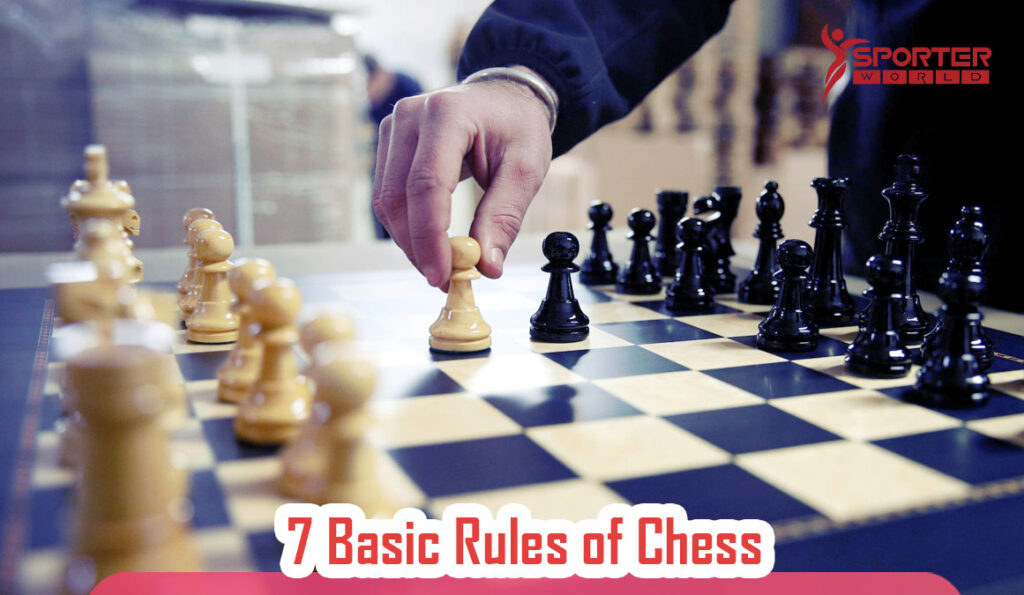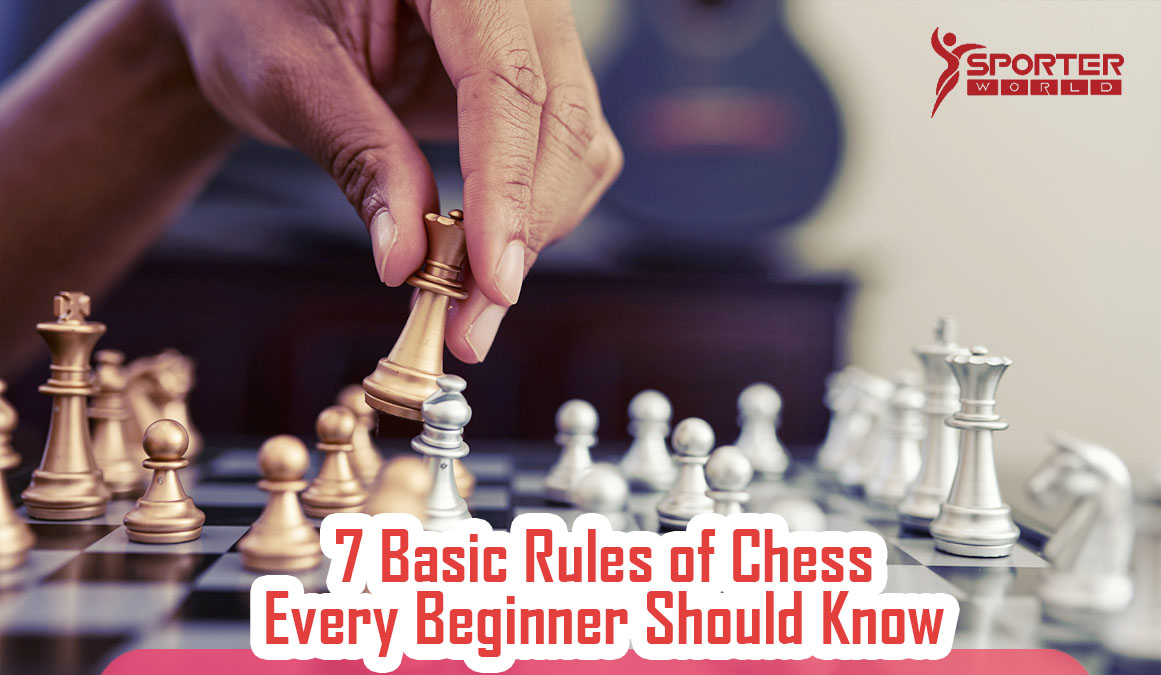Chess is not just a game of strategy and intellect; it’s a battle of wits that has fascinated people for centuries. Whether you’re a beginner looking to learn the rules or a seasoned player seeking to brush up on your skills, understanding the fundamental rules of chess is essential to becoming a formidable opponent. So, let’s dive into chess and learn the rules governing this captivating game.
In chess, every piece has its unique movements and powers. Each piece plays a crucial role in shaping the game’s outcome, from the nimble pawn to the mighty queen. By mastering how each piece can move across the board, you gain a tactical advantage that can lead to victory. So, whether you’re just starting or looking to refine your strategies, let’s unravel the mysteries of chess and arm you with the knowledge to outmaneuver your opponents.
Here are 7 Basic Rules of Chess

Step 1: Setup, Turns, and Taking Pieces
Chess is an age-old game of strategy and skill, where two players take turns trying to best the other. It starts with setting up the board, which should always have a white square at the closest right-hand side for both players. The queen must also be placed on a square that matches her color. The game begins when White moves first and alternates with the second player, who will also move one piece at a time unless castling (explained later).
Taking pieces is integral in chess, so when opponents encounter each other in their moving path, they take each other’s pieces (except for pawns which take differently than they move). Players can never take or move through their pieces during a chess game. Therefore, it can become quite tricky to strategically decide how many pieces you are willing to lose to prevail overall.
Step 2: Pawn Rules
The pawn is the least powerful piece in the game, yet it can make or break a strategy. The pawn is unique in that it moves and captures differently. Generally, pawns move forward one square at a time, but they have two exceptions: when they first move, they can either go one square forward or two squares; when capturing, they move diagonally to the square occupied by the opponent’s piece. In addition, pawns reach the other side of the board and can be promoted to any other chess piece, including a queen.
Also Read: All-Time FIFA Women’s World Cup Winners
Step 3: Knight Movement
Knights are an integral part of many standard chess games. They are the only pieces on the board that can jump over other pieces. This gives knights a distinct advantage and makes them incredibly useful for strategic purposes. A great tip when remembering how to move a knight is to imagine it forming an “L” shape. This means two spaces forward, backward, or side-to-side and then one space at a right angle – all in one swift movement! Knights can be difficult for your opponent to counter if placed cleverly due to their unpredictable nature and quick movements.
Step 4: Bishop Movement
Bishops are important to any chess strategy since they can move as no other piece can. A bishop moves diagonally and never changes color for the entire game. That means if you have a white bishop at the beginning of the game, it will always stay on the white squares and never move to the black ones. This allows bishops to cover a larger board area and block their opponent’s pieces.
Step 5: Rook Movement
Rooks are powerful pieces that can be used for both offense and defense. They move in straight lines horizontally or vertically across the board, making them capable of covering a large area quickly. Rooks can also be used to control the center of the board, as they can attack and defend multiple squares at once.
Step 6: Queen Movement
The Queen is one of the strongest pieces on the chess board and arguably has the most freedom in movement. She can move forward, backward, and side-to-side along straight and diagonal lines; no other piece on the board has this range of ability. Many players consider her power infinite, as she can threaten multiple pieces simultaneously with her arresting pattern of lines. Thanks to this versatility, it is important for players to keep an eye on its location at all times.
Step 7: Castling Rules
Castling is an important move in chess and can be used to protect the king and develop the rooks. To castle, a player moves their king two squares towards either side of the board and then places the rook on the other side. This move can only be made if all the pieces between them have not been moved yet, and it can only be done once on each side of the board. Castling is an important move to know and understand since it is a great way to gain more control over the center of the board.
Step 8: King Movement
The King is the most important piece in chess, and it must be protected at all costs. The King has a unique form of movement called casting, which allows the player to move their king two squares towards either side of the board and then place the rook on the other side. This can only be done once per game on each side of the board.
Step 9: En Passant Rule
En passant is a special move exclusive to pawns. It occurs when a pawn moves two squares on its first move and passes an enemy pawn that could have captured it had the first move been only one square. The enemy pawn can then capture the passing pawn “en passant”. This is done by moving their pawn to the square the passing pawn moved from. The captured pawn is then removed from the board. En-passant is a useful tactic to know since it can be used to capture an opposing pawn while also avoiding counterattacks.
Step 10: Pawn Promotion
Pawn promotion occurs when a pawn reaches the opposite side of the board and must be exchanged with any other piece except for a king. The choice of which piece to exchange with is up to the player, and it can be a great way to gain an advantage late in the game. Pawn promotion can also be used to avoid checkmate since no matter what piece is promoted; it cannot place the king into check.
How to Capture Pieces?

Capturing pieces is an essential component of many popular board games. Capturing pieces allows players to strategically position their pieces to gain an advantage over the other player. Capturing pieces can occur when one piece lands on a space with an opponent’s piece. When this happens, the opponent’s piece is taken off the board and removed from play.
This eliminates the opponent’s control of that space and removes that piece from future plays. In addition, two pieces of the same color cannot be placed on the same square; this would immediately end the game as it would be impossible to win.
When a piece captures an opposing player’s piece, it must finish its current move action before being allowed to end its turn. This should always be considered while deciding which piece to move and considering how many turns ahead they may need to plan for to complete their strategy or achieve victory more quickly. Capturing pieces takes skill and strategic thinking; it requires anticipation, knowledge of possible actions from opposing players, and quick reactions during intense gameplay situations. Knowing how to capture pieces and when can often mean the difference between winning and losing a game.
Frequently Asked Questions
FAQ 1: What are the basic rules of chess?
Answer: The basic rules of chess involve moving the pieces on a square board. Each player starts with 16 pieces, including a king, queen, rooks, knights, bishops, and pawns. The objective is to checkmate the opponent’s king, meaning to put it in a position where it is in check (under attack) and cannot escape capture.
FAQ 2: How does pawn promotion work?
Answer: When a pawn reaches the opponent’s eighth rank, it can be promoted to any other piece (except a king). Usually, players choose to promote it to a queen for its powerful abilities. However, it can also be promoted to a rook, bishop, or knight, depending on the situation.
FAQ 3: What is the 50-move rule?
Answer: The 50-move rule states that the game is declared a draw if there have been no captures or pawn movements in the last 50 moves by each player. This rule exists to prevent players from prolonging an already drawn position unnecessarily.
FAQ 4: Can a player move their king into check?
Answer: No, it is not allowed to move the king into a position where it is under attack. The opponent’s piece checking the king must be either captured, blocked, or moved away in order to avoid checkmate.
FAQ 5: Can pawns move backward?
Answer: No, pawns can only move forward on the chest diagonally and cannot capture pieces directly in front of them. board. However, on their first move, they have special non-capturing moves, where they can move one or two squares forward.
Conclusion
Understanding the rules of chess and how to capture pieces is essential if you want to succeed. Knowing when to promote pawns, move your king into check, or use the 50-move rule are all important skills that will be useful during a match. Anyone can learn how to play this timeless game with practice and dedication.



